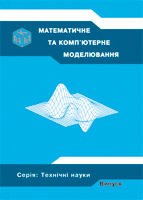Інструментальні засоби непараметричної ідентифікації нелінійних динамічних систем на основі моделей Вольтерра у частотній області
DOI:
https://doi.org/10.32626/2308-5916.2014-11.107-116Ключові слова:
nonlinear dynamical systems, Volterra models, frequency domain, nonparametric identification, polyharmonic signals, multidimensional frequency characteristics, identification toolkit.Анотація
The software-hardware tools used for nonlinear dynamical systems nonparametric identification based on Volterra models in frequency domain are presented. The polyharmonic test impacts are selected as the test ones. The proposed methodology and the toolkit are used for building the communication channel model.
Посилання
Пупков К. А. Методы классической и современной теории автоматиче-ского управления. Статистическая динамика и идентификация систем автоматического управления : учеб. для вузов : в 5 т. / К. А. Пупков, Н. Д. Егупов. — М. : Изд-во МГТУ им. Н. Э. Баумана, 2004. — Т. 2. — 638 с.
Данилов Л. В. Теория нелинейных электрических цепей / Л. В. Данилов, П. Н. Матханов, Е. С. Филиппов. — Л. : Энергоатомиздат, 1990. — 256 с.
Doyle F. J. Identification and Control Using Volterra Models / F. J. Doyle, R. K. Pearson, B. A. Ogunnaike. — London : Springer Technology & Industrial Arts, 2001. — 314 p.
Giannakis G. B. A bibliography on nonlinear system identification and its ap-plications in signal processing, communications and biomedical engineering / G. B. Giannakis, E. Serpedin // Signal Processing — EURASIP, Elsevier Science B.V. — 2001. — Vol. 81. — №3. — P. 533–580.
Верлань А. Ф. Комп'ютерне моделювання в задачах динаміки електроме-ханічних систем : [монографія] / А. Ф. Верлань, В. А. Федорчук, В. А. Іва-нюк. — Кам'янець-Подільський : Кам'янец-Поділ. нац. ун-т ім. І. Огієнка, 2010. — 203 с.
Верлань А. Ф. Моделі динаміки електромеханічних систем / А. Ф. Вер-лань, В. А. Федорчук. — К. : Наук. думка, 2013. — 221 с.
Pavlenko V. D. Identification of Systems Using Volterra Model in Time and Frequency Domain / V. D. Pavlenko, S. V. Pavlenko, V. O. Speranskyy // In book: «Advanced Data Acquisition and Intelligent Data Processing». Vladimír Haasz, Kurosh Madani (Eds.) — River Publishers, 2014. — Chapter 10. — P. 233–270.
Pavlenko V. Modified Approximation Method for Identification of Nonlinear Systems Using Volterra Models in Frequency Domain / V. Pavlenko, V. Sper-anskyy, V. Ilyin, V. Lomovoy // Applied Mathematics in Electrical and Com-puter Engineering. — Published by WSEAS Press, 2012. — P. 423–428.
Павленко В. Д. Автоматизированная система контроля каналов связи телекоммуникационных систем [Электронный ресурс] / В. Д. Павленко, В. А. Сперанский // Передовые информационные технологии, средства и системы автоматизации и их внедрение на российских предприятиях : труды Междунар. науч.-практ. конф. AITA-2011, 4-8 апреля 2011, Россия, Москва, Ин-т проблем управлния им. В. А. Трапезникова РАН. — М. : ИПУ РАН, 2011. — С. 1023–1031.
Pavlenko V. D. Interpolation Method of Nonlinear Dynamical Systems Identi-fication Based on Volterra Model in Frequency Domain / V. D. Pavlenko, S. V. Pavlenko, V. O. Speranskyy // Proceedings of the 7th IEEE International Conference on Intelligent Data Acquisition and Advanced Computing Systems: Technology and Applications (IDAACS’2013), 15-17 September 2013, Berlin, Germany. — 2013. — P. 173–178.
##submission.downloads##
Опубліковано
Номер
Розділ
Ліцензія
Authors who publish with this journal agree to the following terms:- Authors retain copyright and grant the journal right of first publication with the work simultaneously licensed under a Creative Commons Attribution License that allows others to share the work with an acknowledgement of the work's authorship and initial publication in this journal.
- Authors are able to enter into separate, additional contractual arrangements for the non-exclusive distribution of the journal's published version of the work (e.g., post it to an institutional repository or publish it in a book), with an acknowledgement of its initial publication in this journal.
- Authors are permitted and encouraged to post their work online (e.g., in institutional repositories or on their website) prior to and during the submission process, as it can lead to productive exchanges, as well as earlier and greater citation of published work (See The Effect of Open Access).

